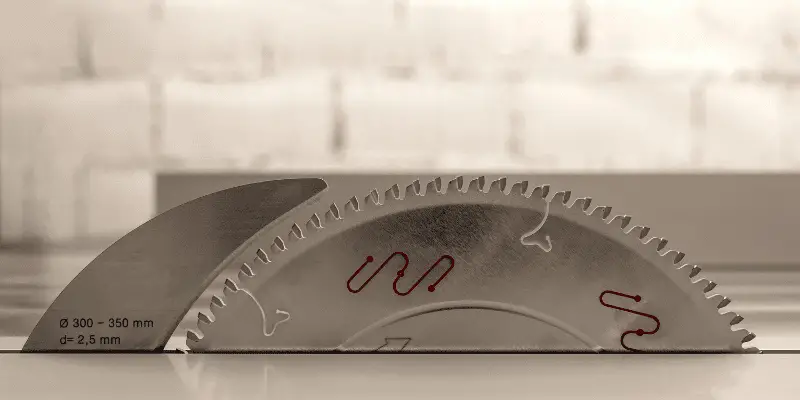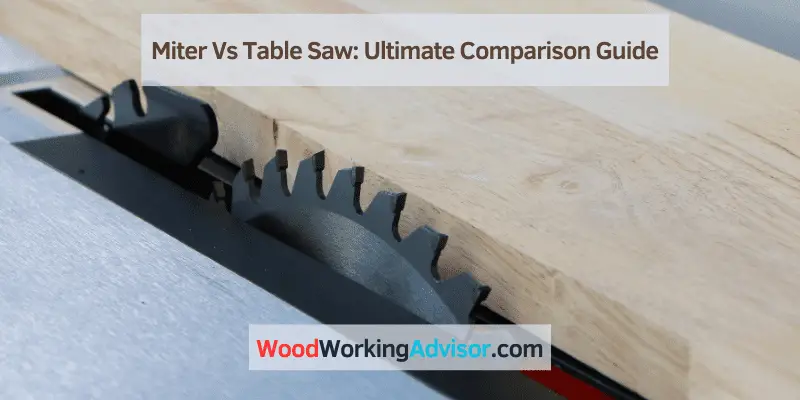When deciding between a miter saw and a table saw, understanding their distinct capabilities is crucial. A miter saw is ideal for making precise angled cuts, perfect for trim work and framing, while a table saw is better for making straight cuts on larger pieces of wood.
Both tools have their unique strengths and should be chosen based on the specific cutting needs of the project at hand. We will explore the differences between these two saws, their respective advantages, and the types of projects they are best suited for.
By the end, you will have a clearer understanding of which saw is best for your woodworking needs.
Understanding The Purpose And Functionality
Miter Saw’s Capabilities
A miter saw is designed for making precise angled cuts, primarily for molding, picture frames, and other decorative woodworking projects. It features a circular blade that is mounted on an arm, allowing it to pivot for angled cuts. The miter saw excels at crosscuts, miter cuts, and bevel cuts, making it a versatile tool for professional carpenters and DIY enthusiasts alike.
Table Saw’s Capabilities
A table saw is a powerful tool used for making straight and accurate cuts in wood. It consists of a flat tabletop surface with a circular blade protruding from the center. The blade can be adjusted to different heights and angles, allowing for rip cuts, crosscuts, and bevel cuts. With attachments and accessories, a table saw can also handle dado cuts, rabbet cuts, and more, making it an essential tool in woodworking shops.

Features And Design Comparison
When it comes to woodworking, having the right tools can make all the difference. One of the most common debates in woodworking circles is the comparison between a miter saw and a table saw. Both are essential tools with distinct features and designs that make them suitable for different tasks. Let’s delve into the features and design comparison of each to understand their unique capabilities.
Miter Saw’s Key Features
A miter saw is a specialized saw designed to make accurate crosscuts and miter cuts at various angles. It is commonly used for cutting moldings, picture frames, and other angled cuts in wood. Some key features of a miter saw include:
- Ability to make precise angled cuts
- Mounted on a pivoting arm for bevel cuts
- Equipped with a miter gauge for rotational angle adjustments
- Compact and portable design for easy maneuverability
- Dust collection system for a cleaner workspace
Table Saw’s Key Features
A table saw is a versatile tool that excels at making straight cuts in various materials, particularly large sheets of wood. Its key features include:
- Ability to make precise straight cuts and rip cuts
- Equipped with a rip fence for straight line guidance
- Large, flat work surface for supporting materials
- Adjustable blade height and angle for different cuts
- Optional accessories for specialized cuts, such as dado blades
Precision And Efficiency Considerations
When it comes to woodworking, the choice between a miter saw and a table saw often boils down to precision and efficiency. Both tools offer distinct advantages in accuracy and speed, making them indispensable in any workshop. Let’s take a closer look at how each tool measures up in terms of precision and efficiency.
Miter Saw’s Accuracy And Precision
The miter saw is renowned for its precision cutting capabilities. With its rotating blade and miter gauge, it allows for highly accurate angle cuts and fine detailing on a variety of materials. The ability to make angled cuts with utmost precision is a hallmark of the miter saw, making it a preferred choice for tasks that demand exceptional accuracy.
- Rotating blade for versatile cutting angles
- Miter gauge for precise angle adjustments
- Exceptional accuracy in angle and fine cuts
Table Saw’s Efficiency And Precision
The table saw, on the other hand, stands out for its efficiency in straight-line cutting. It excels in ripping large stock and squaring edges with speed and consistency. While its primary strength lies in straight cuts, modern table saws also offer impressive precision through features such as fine-tuned fence systems and advanced blade adjustment mechanisms.
- Rapid and consistent straight-line cutting
- Efficient for ripping large stock
- Modern features for enhanced precision
Safety And Versatility Assessment
When it comes to woodworking, choosing the right tools is crucial. Two popular options for cutting wood are the miter saw and the table saw. Each tool has its unique safety features and versatility, which are vital factors to consider when deciding between the two. In this section, we will delve into the safety features of the miter saw and the versatility and safety considerations of the table saw.
Miter Saw’s Safety Features
The miter saw, also known as a chop saw, is designed with safety in mind. Its blade is enclosed in a protective guard, minimizing the risk of accidental contact with the sharp blade. Additionally, many miter saws are equipped with safety triggers that require deliberate finger action to initiate the cutting process, reducing the likelihood of unintended use. The miter saw also comes with a sturdy fence that helps stabilize the workpiece during cutting, further enhancing the overall safety of the tool.
Table Saw’s Versatility And Safety Considerations
Table saws are renowned for their versatility, allowing woodworkers to make a wide range of cuts with precision. However, this versatility also comes with safety considerations. It’s crucial to use a quality blade guard and a riving knife to prevent kickback and protect hands from accidental contact with the spinning blade. Furthermore, advanced table saw models are equipped with safety features such as flesh-sensing technology that can instantly stop the blade upon detecting skin contact, reducing the risk of severe injuries.
Project Suitability And Cost Analysis
It’s essential to understand the project suitability and cost analysis when deciding between a miter saw and a table saw. Each tool has its ideal projects and associated costs, and making an informed choice can save time, effort, and money in the long run.
Miter Saw’s Ideal Projects And Costs
A miter saw is ideal for projects that require precise angled cuts, such as crown molding, picture frames, and trim work. Its ability to make accurate crosscuts and miter cuts makes it well-suited for angled woodworking projects. The cost of a miter saw can vary depending on the features and quality. Basic miter saws can be affordable for casual DIYers, while high-end models with advanced features may come at a higher price point.
Table Saw’s Ideal Projects And Costs
On the other hand, a table saw is suitable for larger woodworking projects that involve straight and long cuts, such as ripping lumber and plywood. It provides stability and precision for long straight cuts and is often used for building furniture, cabinets, and other large-scale projects. Table saws typically have a higher initial cost compared to miter saws due to their larger size and motor power. However, they offer versatility and efficiency for a wide range of woodworking tasks.
Frequently Asked Questions On Miter Vs Table Saw
What Are The Main Differences Between A Miter Saw And A Table Saw?
A miter saw is ideal for making crosscuts and miter cuts, while a table saw is best for rip cuts and larger sheet goods. Both tools have distinct purposes, with the miter saw excelling at angled cuts and the table saw excelling at straight cuts.
Can A Table Saw Be Used To Make The Same Cuts As A Miter Saw?
While both tools can make some similar cuts, a table saw is limited in its ability to make precise angled cuts. A miter saw offers greater versatility and accuracy when it comes to achieving angled cuts, making it a better option for projects that require a high level of precision.
Which Tool Is More Suitable For Cutting Molding And Trim – A Miter Saw Or A Table Saw?
When it comes to cutting molding and trim, a miter saw is better suited for the job due to its ability to make precise angled cuts. The miter saw offers a more efficient and accurate approach to working with molding and trim compared to a table saw.
Conclusion
In weighing the options of a miter saw versus a table saw, it’s clear that both have their distinct advantages and applications. Understanding the unique capabilities of each tool is crucial in making an informed decision for your specific woodworking needs.
Whether it’s precision crosscuts or smooth rip cuts, choosing the right tool ultimately depends on the nature of the project at hand. Keep in mind that the ideal tool for your project may vary, so consider the specific requirements and the versatility of each saw.
By assessing these factors, you can ensure that your workshop is equipped with the right tool for the job.


